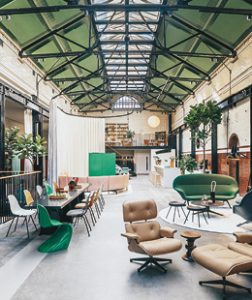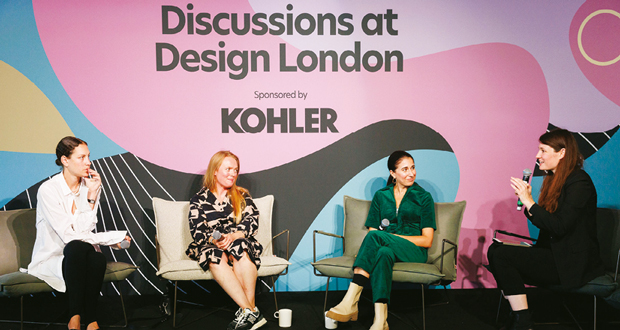The London Design Festival celebrated an impressive 20 years in 2022, with the usual mix of museum exhibits, installations, exhibition and talks programmes. Helen Parton reports
Among the highlights of the festival was a thought-provoking discussion on the Power of Partnerships held at a site within Borough Yards, the large-scale new retail and hospitality district located adjacent to the historic Borough Market in London Bridge.
Hosted by BDG architecture + design and lighting designers and manufacturers FUTURE Designs, it focused on the importance of collaboration and its countless benefits and efficiencies when all parties are engaged and working towards a common goal from the earliest time in the project duration. From a facilities perspective, this impacts how commercial building projects are run, managed and evaluated.
Colin Macgadie, BDG’s Chief Creative Officer commented: “When we come up with conceptual ideas that are outside of the norm, the client understands, having worked together for so long, there’s a genuine purpose and meaning behind something being so unique.”
Using the example of the spectacular AERO313 luminaire, manufactured in the UK and delivered to Detroit during a global pandemic, as an example of what can be achieved with vision and empowerment, David Clements, Managing Director, FUTURE Designs said: “If we’re involved early enough within the contract, I believe there are massive benefits in it,”.
To celebrate the development of AERO313, the only complete example in the UK was installed at Borough Yards, a temporary state-of-the-art design addition which has transformed a series of formerly disused warehouses, arches, and viaducts.
MATERIAL MATTERS
Further along the southern bank of the Thames was Material Matters, a show based on the critically acclaimed podcast by UK-based design, craft and architecture writer Grant Gibson. For the inaugural Material Matters, designers, makers and manufacturers explored the value of materials – particularly waste and our need for circularity and giving materials a new lease of life. Given the fact that the everyone from property investors and developers to the real estate teams including facility managers through to end users are reflecting on more sustainable choices, it prompted some pertinent points for discussion.
The show included installations, a marketplace and extensive talks programme, bringing together over 40 brands, designers, makers and organisations to celebrate the importance of materials. These include Smile Plastics, which creates sustainable materials from ‘waste’ plastics collected from a variety of post-consumer and post-industrial sources, Norwegian-based brand, Fora Form, which specialises in creating spaces where people gather and SolidWool, which made a seat from a combination of Herdwick wool and bio-resin.
DESIGN LONDON SHOW
The Design London show, which returned to one of the London Design Festival’s newest design districts, Greenwich Peninsula featured the latest products from manufacturers, trend forecasts and panel sessions. This included a particularly pertinent one on the world of workspace. The ‘Life Changing Spaces’ session explored what we really need from a space to support our wellness needs with panellists Yaara Gooner, Head of Architecture and Design at LABS, Jo Littlefair, Director and Co-Founder of Goddard Littlefair, and Nadia Themistocleous, interior designer with Trifle.
Over in Shoreditch, Vitra showcased its new London HQ. During LDF visitors were able to see how the 920 square metre exhibition space was divided into three main areas. On the ground floor, ‘The Club’ is an office installation first tested at Vitra’s Swiss HQ, geared towards the post-pandemic needs of people and companies.
 The Club at the Tramshed follows this initial template with a large bar and varied zones, demonstrating how the informal working and collaboration concept can be adapted to changing spatial conditions. ‘The Cottage’ – a space given over to hosting events and meetings located on the first floor of the Tramshed is to open in 2023.
The Club at the Tramshed follows this initial template with a large bar and varied zones, demonstrating how the informal working and collaboration concept can be adapted to changing spatial conditions. ‘The Cottage’ – a space given over to hosting events and meetings located on the first floor of the Tramshed is to open in 2023.
Down the road into Clerkenwell, Italian furniture manufacturer Arper unveiled its latest collections which reflect how the boundaries between home and work have blurred. Launches include the Shaal sofa by Doshi Levien which appears to wrap around the user; the Aeeri table by Peter Kunz with its slender scuptural form resembling origami; Ghia low tables by Altherr Désile Park which infuse a sense of harmony and calm into any interior and the Oell side table by Jean-Marie Massaud which cleverly balances aesthetic qualities while neatly providing a comfortable surface for working.
Remaining in the EC1 postcode, Scandinavian design company Offecct unveiled three new designs by international designers including Teruhiro Yanagihara, Ronja Reuber and the late Pauline Deltour which were on display at the Flokk showroom. Yanagihara’s Sou sofa is based on a spatial perspective where the furniture works as a flexible jigsaw puzzle while German-born Ronja Reuber presented a stripped-down, geometric and playful bar stool.
Whether individual designers and manufacturers, or different professions showcasing the benefits of working together, at this year’s London Design Festival, collaboration really was the watchword.





